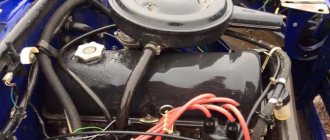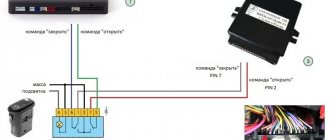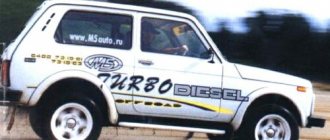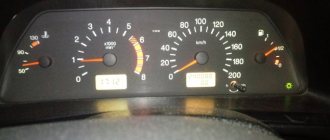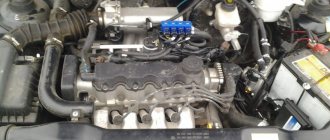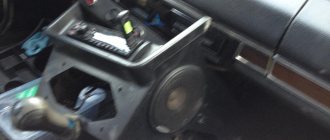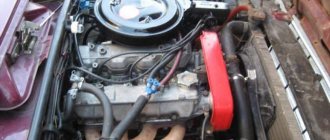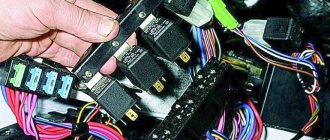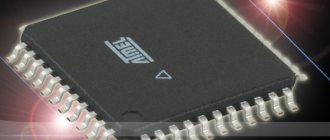Tuning the Niva Chevrolet engine - competently increasing engine power
Many Niva Chevrolet owners note one significant drawback of this SUV - the frankly weak technical performance of the engine.
Having a considerable total weight, and considering that this is still an off-road vehicle, with a power of 80 hp. With. obviously not enough. But this is not the final verdict for this car, because it is possible to refine the engine - tuning aimed at increasing power.
Moreover, this can be done in several ways, or even use them all together to achieve maximum growth.
Engine characteristics
Initially, the Chevrolet Niva was equipped with two engines, depending on the modification - Z18XE and VAZ-2123. After restyling, only the domestic VAZ-2123 engine was left. In the table below you can see the main characteristics of these internal combustion engines.
| characteristic | VAZ-2123 | Z18XE |
| Engine capacity, cc | 1690 | 1796 |
| Maximum torque, N*m (kg*m) at rev. /min. | 127 (13) / 4000 128 (13) / 4000 | 165 (17) / 4600 167 (17) / 3800 170 (17) / 3800 |
| Maximum power, hp | 80 | 122 — 125 |
| Maximum power, hp (kW) at rev. /min. | 80 (59) / 5000 | 122 (90) / 5600 122 (90) / 6000 125 (92) / 3800 125 (92) / 5600 125 (92) / 6000 |
| Fuel used | Gasoline AI-92 | Gasoline AI-92 Gasoline AI-95 |
| Fuel consumption, l/100 km | 10.09.2018 | 7.9 — 10.1 |
| engine's type | In-line, 4-cylinder | In-line, 4-cylinder |
| Cylinder diameter, mm | 82 | 80.5 |
| Number of valves per cylinder | 2 | 4 |
| Add. engine information | distributed fuel injection | distributed fuel injection |
| Piston stroke, mm | 80 | 88.2 |
| Compression ratio | 9.3 | 10.5 |
| Supercharger | No | No |
| CO2 emissions, g/km | 238 | 185 — 211 |
| Engine life thousand km. | 150-200 | 250-300 |
Drivers are often interested in the location of the engine number. Now it is not required to register a car, but in practice it is still sometimes worth checking its compliance. On the Z18XE it is difficult to find it; it is located at the ebb of the engine near the gearbox. Embossed by laser engraving.
On the VAZ-2123 the marking is located between the 3rd and 4th cylinders. It can be counted without any problems if necessary.
Please note that quite often the number is subject to corrosion. Therefore, after purchasing a car second hand, it is recommended to check the quality of the license plate and, if necessary, clean it. To protect the marking, simply lubricate the area with grease or lithol.
A little about the characteristics and prospects
Of course, the engine must have more serious characteristics compared to its predecessor, because without this the entire replacement will be pointless.
As was said, many engines from other cars can be installed on the VAZ-2121, but the most preferable are
: XUD9TE, D8A. 1.9 l, 90 hp, fits perfectly into the Niva, has 190 Nm at 2200 rpm, spins up to 4400 rpm, weighs a little more than 120 kilograms, will need heating of diesel fuel for the winter.
Possible from a Mercedes 1.8 liter
. Many people have a 2.3-liter Fiat Ducato engine on the VAZ 2121, but this option is not the most budget-friendly and not the most powerful; the previous options are better suited for the Niva.
To finally tune the Niva, you can install a turbine, turbocharged Nivas, an incredible picture. However, the installed turbine can have a bad effect on the transfer case and it simply won’t hold up.
Installing a turbine on a Niva costs 35,000-50,000 rubles. You should also remember that the standard Niva engine copes with the turbine, but its power is not enough; you can try to play it, but most often without success.
Basically, the work of the turbine is that, due to the exhaust gases, more friction is acquired, it brings a sensitive gain in horsepower and torque
.
What diesel engines did AvtoVAZ install on the Lada 4×4?
AvtoVAZ saw the need to install a diesel engine on the VAZ 2121, so it made several attempts to modernize its popular SUV. After trial and error, the company was able to place a Peugeot XUD-9SD diesel engine under the hood of the car. From 1999 to 2007, such a diesel Lada 4×4 with the VAZ 21215 index was only exported.
Most recently, the plant produced a prototype Lada 4×4 with a second generation Fiat 1.3 16v MultiJet diesel engine. It took a lot of effort and modification to place it in the engine compartment. It is not known how the tests ended and whether this modification of the SUV will go into mass production.
Cross selling
Basically, the 1.8 engine was chosen by buyers of off-road versions of Cross. For example, in 2021, for 10,725 raised “Vests” there were only 882 regular and 451 “charged” Vesta Sport. During the same time, they bought 4,183 Xray Cross crossovers and only 311 regular Xrays. It is for this reason that AvtoVAZ decided to reduce the variety of its model range.
Cross versions have worse aerodynamics, larger 17-inch wheels, so they need the most powerful engine available. At the same time, the performance of the 1.8 engine is modest by modern standards: 122 hp. and 170 Nm of torque. In the forced version for Vesta Sport it was possible to achieve 145 hp. and 184 Nm of torque - the result is more civil than sporting. So the dynamic characteristics of cars with a 1.8 engine can be called acceptable, for lack of anything better.
Crossover Lada Xray
Diesel Niva: which engine is suitable
Serial versions of the Niva all-wheel drive SUV (Lada 4×4) are traditionally found on CIS roads exclusively with a gasoline engine, although the manufacturer has made attempts to install a diesel internal combustion engine on this model. For this reason, one of the topics related to the popular jeep is the ability to independently install a diesel engine on the Niva.
On serious SUVs, a diesel engine, especially in a simple naturally aspirated version, is a more preferable option compared to a gasoline unit. Such a motor has many obvious advantages:
The main disadvantage is the vulnerability of high-precision diesel fuel equipment, as well as the complexity and high cost of subsequent repairs. In the power supply system of a diesel engine, fuel injection pumps and diesel injectors often fail. The presence of turbocharging (turbodiesel) can also cause certain difficulties during operation, since the condition of the turbine strongly depends on the quality of the fuel and diesel engine oil.
Read in this article
Modified options
Since it is not always possible to supply an engine of a certain foreign car, it is worth considering imported production options that require a little modification:
- The first candidate will again be the French engine from Peugeot XUD 11 series. Since the power of this unit is higher than that of the previous model, some changes will need to be made to the design of the Niva - replacing the gearbox. An acceptable option is a gearbox from Fiat Polonez. In addition, a good solution would be to replace the front supports of the power plant fasteners, pan and exhaust system. It is also worth replacing the drive elements with similar parts from the Chevrolet Niva.
Features of installing a diesel engine on a VAZ 2121
If the manufacturer does not provide the opportunity to buy a Lada 4×4 with a diesel engine, then craftsmen will appear who will install it with their own hands. So, which diesel engine is suitable for the VAZ 2121? Here are the most popular models:
- Peugeot XUD-9SD (1.9 l, about 70 hp) together with Fiat Polonez gearbox.
- Peugeot XUD 11 with Fiat Polonez gearbox.
- Toyota 3C (79 hp) or 3ST (100 hp) together with Toyota Noah gearbox.
- Motor from Volkswagen Vento.
- And many others.
To install a diesel engine, a large number of modifications will be required. The simplest and most common way of such tuning is to use the engine that was installed for export versions of the SUV (XUD-9SD). Its installation requires the least amount of changes to the machine design. It has a good location of the oil intake (in the front, not in the center or rear), the oil filter (on the front left, like the Lada 4x4) and attachment points to the body. In addition, it is easy to find spare parts for this engine model. The approximate procedure is as follows:
- Engine mounts are suitable for VAZ 21215.
- The gearbox bell and the box itself fit well from Fiat Polonez.
- Rework the pan, oil intake, flywheel, exhaust system, etc.
- The easiest way is to complete all the modifications according to the documents.
In other words, no diesel engine can be installed instead of a gasoline engine without modifications. What do you think, is it necessary to change the Lada 4×4 internal combustion engine to a diesel one? If yes, which one and why? Let us remind you that you can improve off-road performance in an easier way, for example, by installing mud tires.
The traffic police simplifies the installation of a new engine and allows cars with electronic registration certificates to be registered
An order of the Ministry of Internal Affairs has been published with new rules for car registration. Now you won’t have to go to the traffic police and go through complex approvals when replacing the engine with an identical one. For the first time, it will be possible to register a car with an electronic vehicle passport with the traffic police. In addition, citizens will have the opportunity to store the registration plate from a sold car in the unit for a year.
Order No. 399 of the Ministry of Internal Affairs was officially published, approving “the rules for state registration of motor vehicles and trailers for them in the traffic police.” The document comes into force on October 6 and will replace the old registration rules approved by Order No. 1001 of 2008.
The document, the first version of which was reported at the end of last year, contains a number of innovations.
The first is related to electronic vehicle passports (EPTS). Let us remind you that the Russian authorities have been preparing for the introduction of such passports for several years; for this purpose, a special JSC “Electronic Passport” was created, which is part of the structure of the Rostec State Corporation, which is introducing an information system for electronic passports. It is expected that the EPTS will store information not only about the data on the car, but also about technical inspection, compulsory motor liability insurance, possible collateral restrictions on the car, etc.
The introduction of EPTS was postponed several times, and now, in accordance with the order of the Ministry of Internal Affairs, there is a legal basis for registering cars with electronic passports
. The procedure for such registration is prescribed in the new order No. 399 of the Ministry of Internal Affairs. And from November 1, 2021, according to the decision of the Eurasian Economic Commission, the issuance of traditional paper PTS when vehicles are put into circulation will cease. In other words, when purchasing a new car from a dealer or importing a car from abroad, it will be immediately issued with an electronic title. But for cars that have already been put into circulation, the traditional paper PTS continues to be valid - it does not expire, it will be possible to obtain a duplicate of it (this option is included in the new order): replacement with an EPTS is exclusively voluntary.
How the legalization of constructive recycling of cars became a public service
Another important innovation concerns the installation of a new engine in the car.
. Until now, car owners have encountered a number of problems when installing a new power unit - traffic police inspectors, in particular, demanded that a separate purchase and sale agreement be presented for the motor and in certain cases refused to register the car. Now all this is a thing of the past. From October 6, it will be possible to install a new engine in a car (we are talking about replacing the engine with an identical one that is legally clean) and drive such a car without any additional actions. The traffic police inspector on the road does not check anything, since the engine number does not relate to the registration data - it is indicated only in the vehicle title, and the driver is not required to carry it with him.
When selling a car to a new owner, any additional documents for the engine are also not needed: the inspector at the site, seeing that a motor from another car is installed, will check whether the markings have been changed, whether the motor has been put on the wanted list, whether the design of the car has changed (installation adding a more powerful engine to a car is considered a design change). If no questions arise, information about the new engine is entered into the title when registering the car.
Improved Niva
The injector installed on the Niva, although it reduces fuel consumption, is still not the most economical option in urban conditions with traffic jams and other delays. On the highway and during long trips outside the city, this is not felt so much, since the car works without stops and downtime. Due to the unprofitability of cars in urban environments, drivers are thinking about a good and effective replacement for the old injection-type engine in their car. The best option would be a diesel engine for the Niva. It has approximately the same power characteristics, but its fuel consumption is comparatively lower. Also, diesel is less capricious in terms of fuel quality. What options from this category of motors are worth detailed consideration?
The first and most worthy candidate is the XUD 9 SD from Peugeot. This engine was used to create a modified version of the Niva - model 212151 with a French engine. It can be installed on the Niva without any problems - the fastenings of the parts and the assembly are identical, the motor fits perfectly in size, and in addition, there are some advantages from its installation.
Why is replacement carried out?
Surely many were interested in how to install an engine almost from a Hummer on their Daewoo Nexia, Chevrolet Cruze, Chevrolet Niva or some Mitsubishi Lancer, for example.
A new motor is usually required when the standard one has completely failed, it cannot be repaired, has used up its entire service life, etc. That is, even a major overhaul is not always the solution. Operational wear or loss of performance as a result of an accident, mechanical failure and other factors lead to the fact that the driver only has a body with additional components at his disposal, and the engine needs to be replaced. An alternative situation is the desire to increase the power of the car.
How does all this happen under the new rules? What changes were made in 2021 and has anything changed in the current year 2021? Let's figure it out.
Previously, when replacing an internal combustion engine, re-registration of this part with the traffic police was not required. That is, there was no need to go through any additional registration with the traffic police.
Now everything is different. It is mandatory to contact the traffic police. Specialists check the numbers of the engine, body and other components with those presented in the documentation. Data about the internal combustion engine is entered directly into the PTS, that is, the passport of your vehicle. Currently, replacing the motor is considered a design change. What does it mean? This only means that in order to legalize such a replacement, you will have to obtain the appropriate certificates and go through the declaration procedure.
When buying a motor, you should definitely sign a contract and receive a receipt from the seller. Then you go to the traffic police, where you are required to report this procedure. Let me note right away that we are talking specifically about Russia. I don’t know what rules Minsk or Kyiv introduced in this regard. If you know, write in the comments.
Weaknesses of the VAZ 21214 engine
Cylinder block. This weak point appears on various models of Nivov engines, including the previously discussed 21213. Due to insufficient quality control, the assembly unit is manufactured with a high percentage of factory defects. In short, the drilling depth of the intake manifold stud holes is not maintained, causing the holes to meet the camshaft stud holes.
Also interesting: Chevrolet Niva what oil is in a Chevrolet engine
In this way, L-shaped through channels are obtained. After installing the studs at the factory, the connections remain sealed for some time and the problem is not identified when the quality control department employees accept engine tests. After the sale of new cars with low mileage, during sharp braking, oil begins to seep through the studs onto the hot intake manifold, so much so that smoke from the oil burning in the manifold pours out from under the hood, and accordingly, there is nothing to breathe in the cabin.
A sketch for the technical specifications for eliminating oil leaks from under the exhaust manifold studs.
Nissan Pathfinder
Rarely, but still found on sale is the previous Pathfinder. This solid and respected SUV can also be purchased for the cost of a new Niva, albeit about ten years old. Cars are available with a manual transmission and an automatic transmission, equipped with a 2.5-liter diesel engine with a capacity of 174 hp, or a 270-horsepower 4.0 liter gasoline engine.
When purchasing a car this old, you need to be prepared for many problems. For example, you can easily run into a car with a dead (or close to it) transfer case (for the same reason as the Suzuki Jimny: if the previous owner constantly used all-wheel drive unnecessarily). The weak point in the suspension is the ball joints, which often have to be changed after 50,000 - 60,000 km. The steering rack runs for approximately 100,000 km, after which it begins to knock, requiring repair or replacement. The particulate filter or catalyst clogs quickly. The clutch will have to be replaced at about 100 thousand km. But the motors are relatively reliable, unless, of course, outright “poison” was poured into them.
Features of operation
To ensure long-term and trouble-free operation of the power unit, it must be very carefully and properly maintained. It is also recommended not to allow the engine to operate in extreme modes.
First, let's look at the VAZ-2123 engine, it is a modified version of the power unit installed on the “classic Niva”. The main differences are as follows.
The Z18XE engine was widely used in various car models. There are several modifications of the power unit. Installed on the Chevrolet Niva, it had the following features.
The result was an original motor with interesting settings. Thanks to the settings, it is possible to achieve some variation in power and throttle response.
Service
To achieve maximum service life, it is important to properly maintain the motor. First of all, it is worth remembering the importance of timely replacement of engine oil. It is recommended to carry out this work once every 15 thousand kilometers. Every second replacement should be combined with washing. This recommendation applies to both engines.
It is also worth choosing the right oil. The Z18XE engine should only be filled with synthetics; the best options would be:
It will require approximately 4.5 liters.
The VAZ-2123 engine is filled with 3.75 liters of lubricant; here it would also be optimal to use synthetics. For other parameters, you can use the same oil as for the engine described above.
The VAZ-2123 engine has a timing chain drive. In this regard, it is changed quite rarely. The average service life between replacements is 150 thousand kilometers. At the same time, the manufacturer does not regulate the time of replacement. Everything is determined by the signs of a problem, first of all we are talking about increased engine noise, especially when picking up or dropping speed.
The Z18XE motor is belt driven. According to the manufacturer's specifications, it must be replaced at 60 thousand kilometers. And according to the experience of car enthusiasts, it is better to do this after 45-50 thousand, as there is a risk of breakage. In this case, you will get bent valves.
Malfunctions
Quite often, drivers complain about the quality and reliability of the Chevrolet Niva internal combustion engine. In fact, there are quite a few problems here, and first of all we are talking about technical shortcomings. It was previously mentioned that drivers may experience a broken belt on the Z18XE, and in this case, there will be bent valves. This clearly leads to the need for major repairs.
The timing chain drive, which is equipped with the domestic power unit, can also create problems. There is a hydraulic tensioner installed there; it can fail already at a mileage of 50 thousand. If you do not pay attention to this in a timely manner, the chain jumps. Accordingly, we get damaged valves.
Also on the VAZ-2123, hydraulic compensators may fail. This leads to valve knocking and increased fuel consumption. Another standard problem for Russian engines is constant leaks. Oil can escape from under any gaskets, which is not very good.
Both engines have a common problem with the ignition modules. They often fail at a mileage of 100-120 thousand. The first sign of a breakdown can be called engine tripping.
Which clutch is better to put on the Niva to “set it and forget it”
In this article we will tell you how to choose the right clutch for any Niva modification and where you can purchase everything you need with home delivery.
Content:
- What kind of clutch is there?
- We find possible problems and fix them
- Incomplete engagement or slipping
- Insufficient shutdown
- Sudden jerks
- The pedal “fails”
- We choose what to install on your SUV Chevrolet Niva, Niva 2121, etc. Modifications
- VAZ 2121 and other modifications of Niva
- Chevrolet Niva
- Why install a clutch from a Chevrolet Niva on a VAZ 2121?
- Features of Niva clutch maintenance and recommendations on how to extend its life.
What kind of clutch is there?
As always, the search for optimal solutions and answers to questions will begin with terminology. What is clutch? This is an intermediate link between the power unit and transmission.
The principle of operation of the mechanism, in general terms, is that it briefly disconnects the power unit from the gearbox. This ensures smooth mating of transmission elements when shifting gears and dampening of vibrations. The manual transmission is thus protected from unnecessary overloads and, accordingly, increased wear.
Structurally, the friction clutch, as the unit that transmits torque from the engine flywheel is also called, has a whole set of differences. It can be electromagnetic, frictional and hydraulic.
And also “dry”, when the clutches operate without lubrication, and “wet”, when the working elements of the clutch operate in transmission oil. There are permanently and non-permanently closed mechanisms, as well as one, two or multi-disc clutch designs.
Finally, this element can be with a central spring or with several springs arranged in a circle on the pressure plate. The clutch can be either two-threaded or single-threaded.
We will not dive deeper into this ocean of technological delights, since we are interested, first of all, in the question of which clutch is better for the Niva 2121. Let us also pay attention to this car unit in relation to the Chevrolet Niva SUV.
Clutch can be: frictional (such a mechanism transmits torque due to friction forces and is the most common), electromagnetic (the interaction of its elements is subject to the action of a magnetic field), hydraulic (fluid flow ensures the operation of its individual components in such a friction clutch).
We find possible problems and fix them
Below we list the main signs that it’s time to worry about finding a solution to the problem: which Chevy Niva clutch is better. Our list of the main malfunctions of this unit, of course, is not closed; other misunderstandings arise that can complicate the life of the driver, but they are due to special cases, and we present the most common problems:
Incomplete engagement or slipping
Incomplete engagement or slipping of the clutch should immediately alert the driver. The first sign of such a disease is that when driving in 3-4 gears, there is a slight increase in speed when the gas pedal is pressed, as they say, “to the floor.” Leave everything as is, and after some time, due to the fact that one disk slips, and all structural elements are constantly heated from friction, the driven disk will easily move, and the pressure wheel and flywheel may crack.
This deficiency can be “cured” by adjusting the pedal stroke. Inspection and, as an option, replacement of the driven disk may help:
Insufficient shutdown
Insufficient clutch release is the second unpleasant factor. Even with the car stationary, is shifting into gear accompanied by a noticeable crunching sound? Perhaps the pedal “walks” more than necessary and this unit cannot fully perform the task assigned to it, that is, disconnect the engine from the gearbox. To avoid having to repair the box, it is better to pay attention to the condition of the release valve and the quality of lubrication in the clutch. In a double-disc clutch, it happens that the discs become oily and simply stick together. In addition, the clutch “leads” when the input shaft bearing is faulty.
Accordingly, fresh grease or installing a new release bearing may help:
Sudden jerks
Sharp jerks when you smoothly release the pedal are perhaps the most unpleasant news. This is how damaged friction linings or a warped driven disk usually make themselves known. The springs may be broken or the release bearing may have fallen apart.
We get rid of vibration and extraneous sounds of the Niva transfer case forever
The characteristic howl and hum of the transfer case on VAZ-21213 cars, alas, is familiar to many owners of such cars. Let’s figure out what is the reason for these problems, and most importantly, how to get rid of them without using “collective farm” methods, such as additional noise reduction.
Content
- Let's understand the terminology.
- We study problems and repair methods. Vibration and how to deal with it.
- We remove the howl and hum.
- We remove the possibility of oil leakage.
- Niva (LADA 4×4)
Understanding the terminology
Let's start by diving into the materiel. Transfer case (TC) is a separate unit of an all-wheel drive vehicle, which provides multi-mode power distribution from the engine to the front and rear axles.
Externally, this is a mechanism located under the bottom of the car, in the body of which a multiplier (divider) is placed in series to obtain an intermediate gear ratio in the transmission and a splitter of one power flow into two. It is with the help of this device and its controls (levers) that go into the vehicle interior that the LADA 4×4 driver selects the all-wheel drive operating mode.
The RK directly connects the front driveshaft and the intermediate shaft (shaft) with the vibration damper to the vehicle’s gearbox. As is probably already clear from the description, this element is connected to the rear axle of the car via a rear propeller shaft.
We study problems and repair methods.
Any car owner definitely doesn’t need to be told why howling and humming are bad. Vibration of the transfer case on a Niva at low speed is quite common. The driver, of course, gradually gets used to many extraneous sounds in the car, but the noise level is high enough to make it impossible to carry on a conversation with passengers while traveling. Due to excessive noise pollution, you will inevitably have to deal with the problem.
Vibration and how to deal with it.
The main reason for the occurrence of unnecessary sounds is multi-frequency vibrations of the components of the transmission. In general, the vibration of the transfer case on a Niva is one of the most common cornerstones that other car owners are forced to fight (or put up with) constantly.
- Check the cushions (supports) on which the power unit, gearbox and other parts are attached to the body, including the muffler. Any worn-out pad or rubber band can easily cause excessive shaking of the iron and accompanying rumble. It is better to replace worn silent blocks and pillows immediately.
- Be sure to pay attention to the intermediate shaft (inlet shaft). If you see signs of “fatigue” - change the elements that have become unusable, or the entire part!
Perhaps this is the most complete set of measures that experienced auto mechanics advise when the transfer case on a Niva hums and vibrates!
Removing the howl and hum
We will assume that we have dealt with the vibration, but an equally significant problem remains - how to remove the howling of the transfer case on the Niva. Vibrations of the mechanism are not always the only reason for the appearance of extraneous irritating sounds. And the characteristic noise of the transfer case, alas, is one of the “trademark” shortcomings of one of the best domestic SUVs.
- The first thing you should pay attention to is the levers. It is better to immediately replace them with silent ones - with anti-resonance bushings inside. They won’t eliminate all the noise, but they will definitely extinguish some of it.
- The result will be even better if you install a small-module transfer case - with front and rear covers equipped with double-row bearings. In 2010, AVTOVAZ introduced new double-row bearings for output shafts in order to get rid of backlash and runout, as well as extend the life of the seals and, in general, increase the reliability of the mechanism. Here logic is man’s friend: less shaking and hesitation means higher service life and reliability.
Removing the possibility of oil leakage
In an effort to resolve the question of how to get rid of the howling of the transfer case, even before the 2010 update, the manufacturer began assembling this mechanism using silicone sealant instead of cardboard gaskets. And he introduced an improved crankcase ventilation system with an open breather, which was located under the hood. Again, the reliability of the vehicle when passing fords has increased slightly, and most importantly, the load on the seals has also decreased.
We mention them again to point out that the fewer vibrations and shocks, the longer it will not take to detect an oil leak on the transfer case housing due to deteriorated seals. Moreover, the flange in the RC covers can cause noise - during operation, the bearing seats are simply broken.
We hope that the steps listed above will become complete step-by-step instructions on how to eliminate transfer case noise on a Niva.
A universal remedy that will definitely eliminate the noise of the transfer case?
For people who do not want to spend a lot of time modifying the components of their SUV, there is a proven solution. A fairly reliable universal option for how to remove the howling of a transfer case on a Niva, one might say, know-how from the SV-PARTs company, is the installation of a steel four-satellite differential.
Toyota 3S-FE engine with a complete set of parts for installation in a Chevrolet Niva.
What will this give us? What can a motorist win by placing an imported engine in a Niva? And here new imported internal combustion engines will come to the rescue, and a great variety of replacement options can be found.
Although, the selected power unit must meet certain criteria. For example, a Toyota engine in a Niva can fit freely in the engine compartment, so that there is no need to cut off interfering equipment. Moreover, an imported engine, in terms of technical characteristics and, in particular, power, should not differ much from the standard factory Niva internal combustion engine.
It is also worth replacing the drive elements with similar parts from the Chevrolet Niva. There are options from the Japanese concern Toyota - 3C and 3CT. You won't have to change the transmission, but you'll have to tinker with the fastenings. Another acceptable option with modifications is 2JZ.
It will be necessary to install an automatic transmission and update almost all parts of the exhaust system and engine compartment, since the model is too powerful for the standard Niva design. To install, you will have to use a few tricks and buy a few additional parts, but the final effect will please many car enthusiasts.
Conclusion on the topic This is the only analogue that does not require serious intervention in the design of the car. All other options require replacing the fasteners in the engine compartment, improving the gearbox, or strengthening the overall structure of the Toyota Niva engine.
For sports competitions, on the contrary, it is worth improving the power of the standard engine. You will need to install a sports manifold, turbine, camshaft, valve pistons, sports cooling kit, exhaust system and injectors.
All this will allow you to accelerate the engine to hp. Irkutsk companies specializing in serious preparation of jeeps, VAZ frameless all-wheel drive never even consider such a thing. Looking at this specimen, you won’t notice any fundamental deviations from the standard at all. But even this approach did not eliminate all the typical shortcomings of the car - low Toyota engine and traction, high fuel consumption, noise, vibration, roll, shaking.
At the same time, the idea of changing it for the better did not find support from jeep tuning professionals, who simply brushed aside this toy. For this, the 4-cylinder Japanese classic seemed optimal:
Toyota 3S-FE engine with a complete set of parts for installation in a Chevrolet Niva.
What will this give us? What can a motorist win by placing an imported engine in a Niva? And here new imported internal combustion engines will come to the rescue, and a great variety of replacement options can be found.
Although, the selected power unit must meet certain criteria. For example, a Toyota engine in a Niva can fit freely in the engine compartment, so that there is no need to cut off interfering equipment. Moreover, an imported engine, in terms of technical characteristics and, in particular, power, should not differ much from the standard factory Niva internal combustion engine.
It is also worth replacing the drive elements with similar parts from the Chevrolet Niva. There are options from the Japanese concern Toyota - 3C and 3CT. You won't have to change the transmission, but you'll have to tinker with the fastenings. Another acceptable option with modifications is 2JZ.
It will be necessary to install an automatic transmission and update almost all parts of the exhaust system and engine compartment, since the model is too powerful for the standard Niva design. To install, you will have to use a few tricks and buy a few additional parts, but the final effect will please many car enthusiasts.
Conclusion on the topic This is the only analogue that does not require serious intervention in the design of the car. All other options require replacing the fasteners in the engine compartment, improving the gearbox, or strengthening the overall structure of the Toyota Niva engine.
For sports competitions, on the contrary, it is worth improving the power of the standard engine. You will need to install a sports manifold, turbine, camshaft, valve pistons, sports cooling kit, exhaust system and injectors.
All this will allow you to accelerate the engine to hp. Irkutsk companies specializing in serious preparation of jeeps, VAZ frameless all-wheel drive never even consider such a thing. Looking at this specimen, you won’t notice any fundamental deviations from the standard at all. But even this approach did not eliminate all the typical shortcomings of the car - low Toyota engine and traction, high fuel consumption, noise, vibration, roll, shaking.
Niva-Chevrolet diesel
Further attempts to almost “officially” install a diesel engine on the Niva (Niva-Chevrolet model) were made in the city of Togliatti. For this, a tuning studio called “Tema-Plus” received permission from the manufacturer GM-AvtoVAZ. The main modification of the Niva-Chevrolet model was the installation of an Italian diesel engine produced by Fiat paired with a Japanese Aisin transmission.
| Working volume: | 1929 cm 3 |
| Power: | 90 hp |
| Maximum torque: | 195 Nm |
| Average fuel consumption per 100 km: | 7.5 l |
